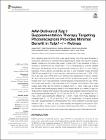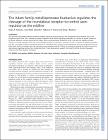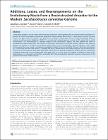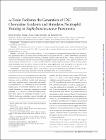Browsing School of Genetics & Microbiology by Title
Now showing items 1-20 of 869
-
A bioinformatics approach to (intra-) genome comparisons
(Trinity College (Dublin, Ireland). School of Genetics and Microbiology, 2002)The analysis of large volumes of genomic data generates special computational needs. A Beowulf-type computer cluster was set up for high-performance computing. Improvements over existing tools for the efficient ... -
The A domain of fibronectin-binding protein B of Staphylococcus aureus contains a novel fibronectin binding site.
(2011)The fibronectin‐binding proteins FnBPA and FnBPB are multifunctional adhesins than can also bind to fibrinogen and elastin. In this study, the N2N3 subdomains of region A of FnBPB were shown to bind fibrinogen with a similar ... -
A functional genomics approach to study plant reproductive development
(Trinity College (Dublin, Ireland). Department of Genetics, 2012)A fundamental question in developmental biology is how differentiated cell types and organs are formed from undifferentiated precursor cells. The establishment of the body plan of an organism is ultimately defined by its ... -
A leaf-specific phage T7 RNA polymerase-based system for transgene expression in tobacco chloroplasts
(Trinity College (Dublin, Ireland). School of Genetics and Microbiology, 2001)This thesis describes the development of a chloroplast-localised gene expression system based on the phage T7 RNA polymerase. In order to direct T7 RNAP expression in a leaf-specific manner and to target it to the ... -
A molecular genetic investigation of Irish origins
(Trinity College (Dublin, Ireland). Department of Genetics, 2000)Three hundred and ninety-four male DNA samples, from Ireland, Turkey and Togo, were genotyped for 5 X chromosome simple tandem repeat (STR) loci. Six Y chromosome STR loci and 8 Y chromosome unique event polymorphisms were ... -
A study of the expression and roles of Bacillus subtilis HtrA-type serine proteases
(Trinity College (Dublin, Ireland). Department of Genetics, 2003)Upon sequencing a region of the Bacillus subtilis genome assigned to the author of this thesis, an open reading frame encoding a homologue of an HtrA-type serine protease, YkdA, was identified. The HtrA serine protease ... -
A study of the regulation of aminoacyl tRNA synthetase gene expression in Bacillus by T-box regulatory elements
(Trinity College (Dublin, Ireland). School of Genetics and Microbiology, 2010)The T-box antitermination mechanism is commonly used for the regulation of aminoacyl tRNA synthetase gene expression in Gram positive bacteria. However, expression of lysyl tRNA synthetases is rarely controlled in this ... -
AAV-Delivered Tulp1 Supplementation Therapy Targeting Photoreceptors Provides Minimal Benefit in Tulp1−/− Retinas
(2020)With marketing approval of the first ocular gene therapy, and other gene therapies in clinical trial, treatments for inherited retinal degenerations (IRDs) have become a reality. Biallelic mutations in the tubby like protein ... -
AAV-PHP.eB transduces both the inner and outer retina with high efficacy in mice
(2022)Recombinant adeno-associated virus (AAV) vectors are one of the main gene delivery vehicles used in retinal gene therapy ap proaches; however, there is a need to further improve the effi cacy, tropism, and safety of these ... -
Accelerated Evolution of Lager Yeast Strains for Improved Flavour Profiles
(Trinity College Dublin. School of Genetics & Microbiology. Discipline of Microbiology, 2022)S. pastorianus is an interspecific hybrid resulting from natural hybridization between S. cerevisiae and S. eubayanus. These two species belong to the Saccharomyces genus, a genus that encompasses different species related ... -
Accurate Determination of Phenotypic Information from Historic Thoroughbred Horses by Single Base Extension
(PLoS, 2010)Historic DNA data have the potential to identify phenotypic information otherwise invisible in the historical, archaeological and palaeontological record. In order to determine whether a single nucleotide polymorphism ... -
Activation of plasminogen by staphylokinase reduces the severity of Staphylococcus aureus systemic infection
(2010)Background. Staphylokinase (SAK) is produced by the majority of Staphylococcus aureus strains. It is an extracellular protein that activates the conversion of human plasminogen (plg) to plasmin. The role played by SAK in ... -
Activation of the PhoPR-mediated response to phosphate limitation is regulated by wall teichoic acid metabolism in Bacillus subtilis
(2018)Phosphorous is essential for cell viability. To ensure an adequate supply under phosphate limiting conditions, bacteria induce a cohort of enzymes to scavenge for phosphate, and a high affinity transporter for its uptake ... -
The Adam family metalloprotease Kuzbanian regulates the cleavage of the roundabout receptor to control axon repulsion at the midline.
(2010)Slits and their Roundabout (Robo) receptors mediate repulsive axon guidance at the Drosophila ventral midline and in the vertebrate spinal cord. Slit is cleaved to produce fragments with distinct signaling properties. In ... -
Additions, losses, and rearrangements on the evolutionary route from a reconstructed ancestor to the modern Saccharomyces cerevisiae genome.
(PLoS, 2009)Comparative genomics can be used to infer the history of genomic rearrangements that occurred during the evolution of a species. We used the principle of parsimony, applied to aligned synteny blocks from 11 yeast species, ... -
Adhesion and invasion by Escherichia coli K1
(Trinity College (Dublin, Ireland). Department of Microbiology, 2006)Escherichia coli is one of the principal causes of septicaemia and meningitis in neonates. Sepsis occurs in approximately one in every thousand live births, with up to 10% progressing to develop meningitis. A disproportionate ... -
Adhesion, invasion and evasion: the many functions of the surface proteins of Staphylococcus aureus
(2014)Staphylococcus aureus is an important opportunistic pathogen and persistently colonizes about 20% of the human population. Its surface is 'decorated' with proteins that are covalently anchored to the cell wall peptidoglycan. ... -
Advanced late-onset retinitis pigmentosa with dominant-acting D477G RPE65 mutation is responsive to oral synthetic retinoid therapy
(2020)Objectives: No therapeutic interventions are currently available for autosomal dominant retinitis pigmentosa (adRP). An RPE65 Asp477Gly transition associates with late-onset adRP, reduced RPE65 enzymatic activity being one ...























